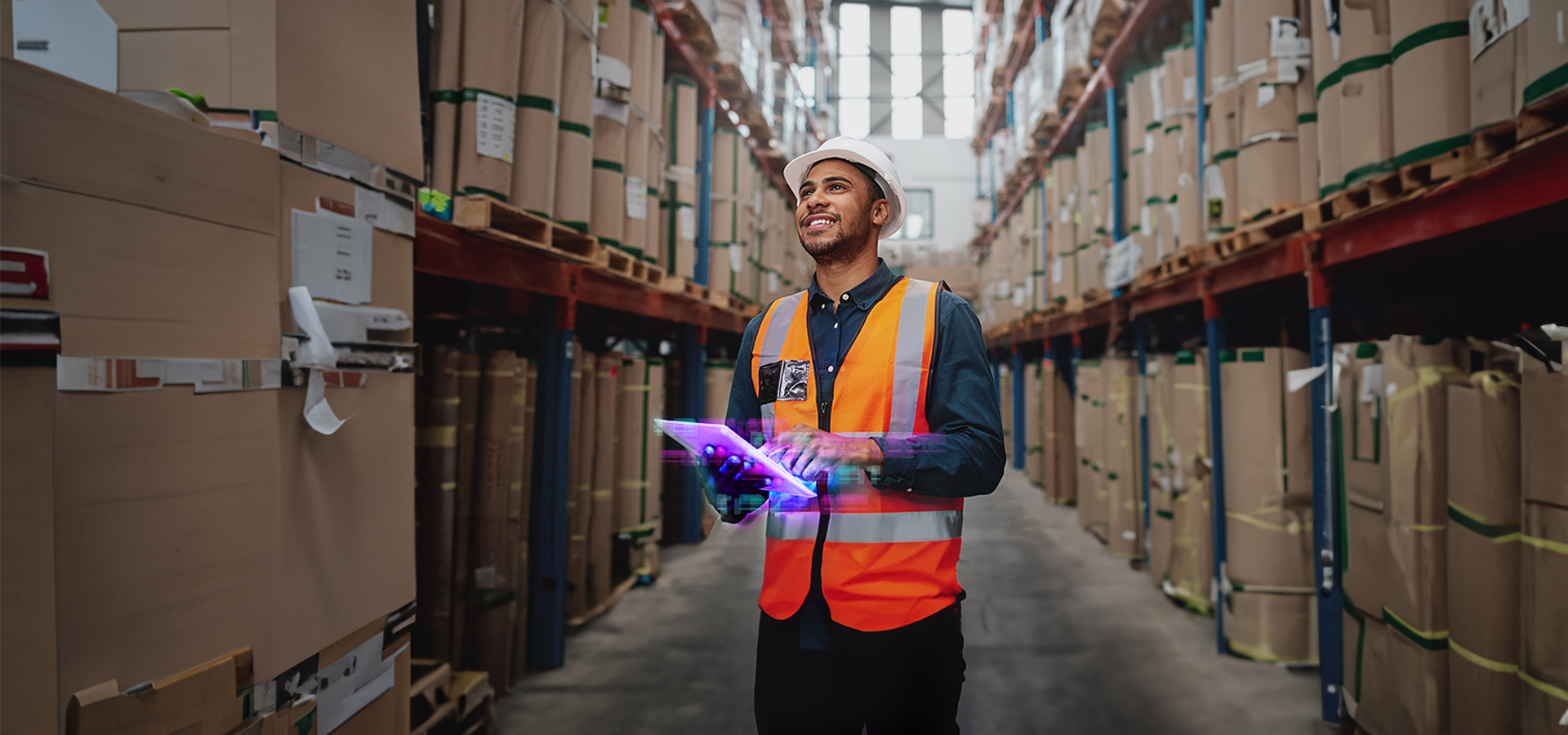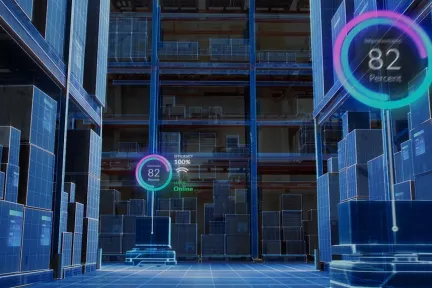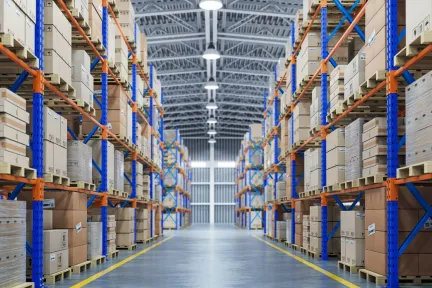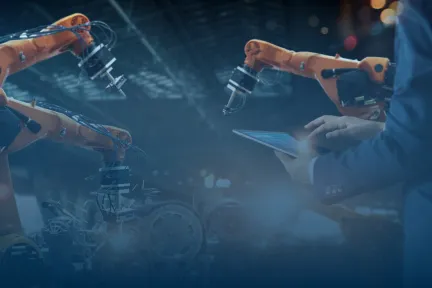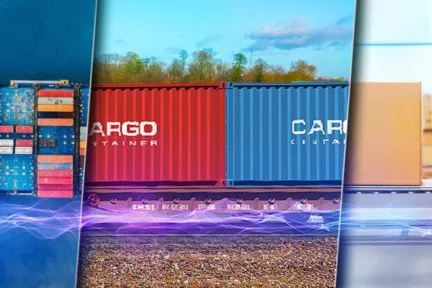#07: Why Does Inventory Management Need Big Data?
Tune in to discover how digital transformation raises inventory management to new heights, unlocking new horizons for manufacturing success.
#07: Why Does Inventory Management Need Big Data?
Join us as we discover how digital transformation bridges the crucial gaps in inventory management. Learn the keys to achieving minimized inventories and maximized throughput through the seamless integration of data visibility, 3D printing and automation, resolving barriers manufacturers face when transitioning to a fully digital approach. Discover more
Meet our speakers
Digital inventory management enables you to reduce future issues and crises through predictive analytics. Its abilities can help a company be truly future-ready.”
Mike Bradford
Read the transcript
Narrator: Welcome back to Disruptors Unleashed, the series that explores the disruptive technologies shaping our world, and the trailblazers igniting change across industries. In our previous episode, we discussed how disassembly can help achieve circularity, with Tim McAloone from the Technical University of Denmark.
Now, we look at inventory. Specifically, how big data, 3D printing, and automation can be harnessed to minimize inventory, maximize throughput, and revolutionize inventory management. Our guests are Melanie Anthony and Mike Bradford from Dassault Systèmes.
Melanie: Hello and welcome to our conversation on manufacturing topics and trends. The future is lean, agile and digital. With me today is Mike Bradford, DELMIA's Strategic Business Development Director. Hello Mike, and thank you for joining us today.
Mike: Hi, Melanie, thank you for having me.
Mike: Sure. There’s a lot of good technology available: Things like RFID (radio-frequency identification), robots and automated guided vehicles or AGVs, automated storage and retrieval systems, and cobots, which are cooperative robots that can work in proximity with human beings and recognize their presence to ensure there are no injuries. Smart bins help with the picking process to ensure operators are getting the right parts out of bins at the line side and several others.
The problem is these are severely underutilized. There’s also a lot of new technology, which is interesting and exciting. Things like smart glasses are being used not just for work instructions in the plant but also in the warehouse to guide picking and putting away. Things like drones inside the warehouse, something called RPA (robotic process automation) — it’s not a robot; it’s actually an AI software that tracks what operators do. And for repetitive tasks, it can actually automate those repetitive tasks.
And then video analytics, which is the capability to automatically analyze video and detect or determine temporal, spatial or time and space-type events. But before you can use these advanced tools, you need to have the basics.
Mike: I really see three key critical gaps. The first one is the lack of automation. We already talked about the fact that it’s very underutilized. McKinsey did a study that showed only about 20% of warehouses are effectively using automation. That’s a very low number, considering how many years some of this automation has been available. And this lack of automation has a very high cost. A 2018 study said that a typical warehouse with 100 non-supervisory employees costs about $3.7 million dollars a year in labor expenses. And those costs are even higher now due to the post-COVID labor shortage. So, there’s a big cost there.
The second critical gap that I see is a lack of integrated, consolidated real-time data. This is due to multiple data silos in multiple systems. This starts a design where a weak link volume between design and actual material flow, or material, exists so that it’s hard to plan effectively for plant layout and material handling. There’s also typically a limited or very little link between your demand and supply planning to your production planning, to your logistics planning, to your execution, without feedback from execution. So, that chain typically is broken in one or more places.
Next, there’s little or no integration between warehouse and production. This is critical — this is key for minimizing inventories and maximizing throughput on your shop floor. The reason this happens is because an ERP system or warehouse system typically has limited visibility into what’s really happening on the shop floor. They know what’s gone into an assembly process and what’s come out, but anything in between is a black hole. So, the only time they’re aware of actual inventory is when an item leaves the assembly line; then, they know all the components for that item have been consumed. But in reality, they’ve consumed different items at different steps in the assembly line. So, the lack of visibility between warehouse and production causes shortages — it causes too much inventory at the assembly line. So, there are a lot of issues with that lack of integration between the warehouse and MES (Manufacturing Execution System).
And then the third gap is: IoT and 3D printing. They’re still looked at as manufacturing apps, which they are. But they can also have great applications or at least great effects in the warehouse in terms of inventory management.
Mike: I’ll take each of these three separately. So first, full data visibility. Full data visibility requires consolidated data from multiple different sources. But it’s key to many benefits in warehouse and inventory management. Ideally, full data visibility starts with virtual models — a virtual twin of the warehouse to ensure the right layout and the right material flow in the warehouse.
So, when you’re building or configuring the warehouse, that virtual twin can give you a picture not only of size and storage space but also of material flow. We’ve got a customer right now who has in their manufacturing facility about 100 AGVs – automated guided vehicles – and they have a spot in their plant that they call ‘Spaghetti Junction.’ Because almost all of those AGVs have to go through this one spot and it becomes a traffic jam, the AGVs actually have to stop and wait for other AGVs to go through. If you can do a virtual twin upfront of not just the facility but the material flows and the AGVs flows, you can alleviate that sort of situation by providing other places and other paths for your AGVs to go.
So, it starts there with a virtual model, then back to the supply and demand planning that requires data from a lot of different areas like data from ERP (enterprise resource planning) to create valid plans. It actually even starts before that — it requires forecasting data, which can be manual or calculated by a system: It requires customer orders from ERP to create those plans. Then, the production plan needs that data plus warehouse and inventory data to know how much we have, where it is and so forth, which typically comes from ERP or warehouse management; actual production data, which comes from WMS (warehouse management system); and purchasing plants, which comes again from ERP. All this data needs to be available in sync together in order to generate and maintain effective plans.
So, it applies to not only all this data together but feedback between execution in production and in the warehouse back to the planning systems and effective execution. The warehouse requires planning data but also real-time production data to meet the needs of your internal customers and your production people while still minimizing inventories.
Back to that situation of the black hole: If you have effective integration, effective visibility and full data visibility between your warehouse and your WMS, then you can synchronize materials to the line in real time. An example of that is we have a customer that builds combines. Every combine on their line is unique. What they are able to do with full data visibility is when a combine hits station two, that triggers a picking event to their warehouse management people to pick a kit specific to that combine for station seven because they know, based on takt time, that gives the warehouse person enough time to go and pick those parts and deliver them to the line. Without that level of visibility from station to station, you’re not able to do that.
Then, performance data. Full data visibility needs performance data in real-time or near real-time. It’s critical to ongoing effectiveness improvements. It enables the identification of bottlenecks, slow-moving inventory, storage, space issues and so forth. And then, the continuity of all this data can provide the basis for predictive analytics to help more effectively manage warehouse space, manage material movement paths and identify storage issues, supply issues and material handling issues before they even occur.
Next, let’s talk robotics. When I’m talking about robotics, I include automated guided vehicles and cobots (collaborative robots), where cobots can work with humans and traditional robotic equipment. Those together can provide significant improvements in several areas; number one is speed. Studies have been done and a human order picker can do about 60 to 80 picks per hour. If you add robots, sorters and conveyors, you can do 300 picks per hour. So, you’re getting a three to five-time improvement in your picking speed.
Another improvement through robotics is safety — by automating the handling of heavy, bulky and awkward items with robots and cobots. You can reduce back injuries, crusher pinch injuries, forklift collisions and so forth. That’s important. Safety is a key measure for most production companies. In 2016, a study showed that 5 workplace injuries occur for every 100 workers each year. So, 5% of your workers experienced injuries in a year. If we can use robots and automation to reduce that, it’s valuable in terms of your safety.
And then, costs. As we mentioned earlier, labor costs are high and going higher. In fact, it’s estimated that labor costs constitute 65% of the warehouse operating budget; that’s a huge number. So, the post-COVID labor issues are going to make that go even higher.
Finally, 3D printing. Raw materials for 3D printing require minimal storage. On-demand 3D printing can enable made-to-order for manufacturers so that you reduce on-hand finished goods inventories, which are your most expensive inventories, and also reduce material handling. This is because now you can take production directly from the production area to the dock rather than taking it from production, putting it in a warehouse, letting it sit there and taking it to the dock. This also enables you to move production closer to your intended market because it requires much less equipment than traditional manufacturing, so you can shorten your supply chain.
3D printing can also reduce or even eliminate the storage space required for spare parts. Because spare parts orders are lower in volume and typically have less stringent delivery date requirements than production parts, they’re a perfect candidate to be 3D printed and immediately shipped on demand. Once again, this significantly reduces the requirements of your warehouse space, material acquisition and material handling. MIT research suggests that adapting 3D printing for those types of parts can reduce spare parts inventory by 90%, yet still ensure 100% availability.
Mike: I see several barriers. The biggest single barrier that I see is those siloed systems and data that I talked about earlier. The lack of integration between systems has a huge impact on the ability to implement effective digital technologies and inventory control.
You can do pieces and you can do parts. But to enable a true, fully digital warehouse, you need to knock down those silos. This is where a broad platform-based solution that crosses multiple functional silos can be a significant enabler for companies seeking a fully digital approach to inventory management.
Another barrier is operational inflexibility. Many companies don’t have the flexibility in their current systems and processes to take full advantage of these capabilities. I’ve heard some systems compare it to cement. When you bring in cement, it’s pliable and you can put it into any shape that you want. Once it sets, you can’t change it. Unfortunately, a lot of software systems are like that as well — once they’re set up, it’s very difficult to change them. You need flexible systems in order to take advantage of that. But those inflexible systems are a significant gap.
And then, finally, many companies focus too much on cost versus value. They’re looking at the cost of these capabilities without really evaluating and understanding the potential value. That’s when something like value engagement – where you have people come in and look at your costs and where and how you can improve – is valuable because when you focus too much on costs, you lose the visibility on what the value is, both short term and long term and how much something like this is worth and how much it can help.
Mike: Future success in manufacturing requires resiliency, and you hear a lot of analysts and consultants talking about that. Well, it requires resiliency in design, production, quality, materials and inventory across your entire supply chain. Digital inventory management is a key component of that resiliency. It provides the ability to minimize inventories and costs in the short term and in the long term, as well as visualize and analyze changes and impacts in real time, so you know what needs to change, what has changed and what the impact is. It enables adjustments to variations in the supply, demand and production process and enables you to react to market and industry changes, which is more of a long-term view. It enables you to reduce future issues and crises through predictive analytics. These abilities can help a company be truly future-ready.
Melanie: Well, Mike, that was the last question I had for you today. Thank you very much for your insights on reshaping inventory management.
Mike: You’re very welcome.
Narrator: Disruptors Unleashed is produced by Dassault Systèmes. For more episodes, follow us on Apple Podcasts, Spotify, Deezer, or your nearest streaming platforms. To learn more about Dassault Systèmes, visit us at 3ds.com.
